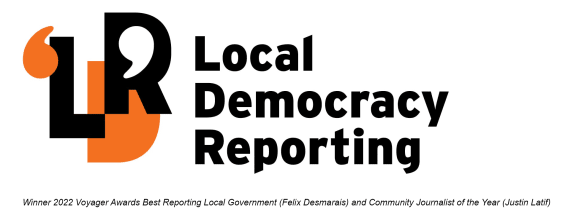
File photo. Whareroa Marae environment spokesperson Joel Ngātuere, Photo: RNZ / Jean Bell
A Tauranga marae is "really disappointed" its people will "continue to get poisoned" because there is no legal reason the heavy industry surrounding it should be relocated.
Whareroa Marae on Taiaho Place has seen Mount Maunganui's industrial area rise up around it since the wharenui was built in 1873.
In 2020 the marae took its concerns about pollutants affecting its people to the Tauranga City Council (TCC) and Bay of Plenty Regional Council (BOPRC) calling for the managed retreat of heavy industry away from their whenua.
An advisory group was set up and an investigation into the potential for managed retreat of heavy industry from Totara Street, south of Hewletts Road began.
That same year the marae also gave the government a 10-year deadline to remove the heavy industry.
At a Tauranga City Council meeting this week it was revealed there was "no feasible pathway" for relocation because many of the industrial activities have existing user rights under the Resource Management Act.
Council strategy growth and governance general manager Christine Jones said the legal advice was many industrial activities in the area had existing use rights under the Resource Management Act and the situation was not likely to change under the current draft of the Natural and Built Environment Bill.
Whareroa Marae environment spokesperson Joel Ngātuere said the news was "really disappointing".
"It's ironic that these industries have existing land use rights but a community that has been there well before the arrival of Captain Cook have been given no rights."
Ngātuere said because of the air pollution people suffer from asthma, migraines, nausea and it impacts their mental health.
"When you are watching your grandparents, your parents, your children and mokopuna/grandchildren be poisoned, there's definite mental health impacts that that has on people."
The marae has elder housing and a kōhanga reo (Māori language preschool) and between 100 and 120 people are on site daily.

"The two most at risk demographics for air pollution are children and elderly and that makes up 79-80 percent of our community," said Ngātuere.
"We are directly impacted because they're [heavy industry] right on our doorstep. But we're not the only ones in the Mount to raise concerns around our respiratory issues.
"This is a well-known issue that's affecting a large portion of people that live within Mount Maunganui."
The air above the industrial zone and marae was designated a polluted airshed in 2019 and in March 2020 public health authorities called for immediate action on Mount Maunganui's air pollution problem, presenting evidence it was harming people's health.
Ngātuere said the large residential area of Mount Maunganui and the industrial area could not coexist.
"It's not just the air pollution, it's the congestion and all of that that all of these industries have on our community.
"The infrastructure is not sustainable for a large residential beach community as well as a large heavy industrial area."

Clear the Air Mount Maunganui spokesperson Emma Jones wants heavy industry to use best practice to mitigate pollution. Photo: LDR / Sun Media /Alisha Evans
Environmental charitable trust Clear the Air Mount Maunganui backed the marae's stance and advocates for the wider community as well.
Clear the Air spokesperson Emma Jones said where there was "unchecked pollution" because of historic granting of existing user rights, it did not make it right that it continued.
"Despite the fact that they have these existing use rights, we as a community feel it's important to look at the bigger picture and the wider impacts on the residents, the communities and the schools."
Emma Jones said the trust was not against the businesses being there.
"We understand that the port plays an important role in the region.
"But the businesses, the heavy industries that are located there need to be operating with the best practice to mitigate their pollution to the environment and harm on the local people and visitors to the community in order to stay."
In terms of next steps for the marae, Ngātuere said: "We're going to continue to press the council and the government."
He said he was hopeful there would be mechanisms put in place for when existing industries apply for new resource consents to discharge into the air, land or water that would review whether they were best located there.

A fertiliser plant is just one of the industrial businesses next to Whareroa Marae. Photo: Local Democracy Reporting/ SunLive - John Borren
Christine Jones said: "Rezoning under the city plan could potentially constrain future activities, but not those protected by existing use rights, and no feasible mechanism has been identified for Tauranga City Council to compel existing industry to relocate away from Whareroa Marae."
Commission chair Anne Tolley said in a statement while the report on existing use rights does not identify a feasible way for the council to advance industry relocation, it is an important step in the work being undertaken with Whareroa Marae and BOPRC to explore future options.
"Mount Maunganui was declared a polluted airshed in late-2019.
"BOPRC has been working with industry and the measures that have been implemented by businesses have resulted in improvements.
"The intent of this ongoing work is to achieve air quality standards which would allow the airshed to be classified as non-polluted over the next decade,"Tollley said.
"BOPRC will report back on this legal opinion to the next Tauranga Moana Advisory Group meeting and set out a path forward.
"The commission is keen to ensure that the current Mount Spatial Plan and Mount Industrial Planning projects explore mechanisms that will better manage future industrial land use.
"That work will focus on what can be done to achieve the aspirations of Whareroa marae hau kainga, mana whenua and the wider community, and whether a move away from emitting industries in this area can be achieved over time."
Local Democracy Reporting is Public Interest Journalism funded through NZ On Air






